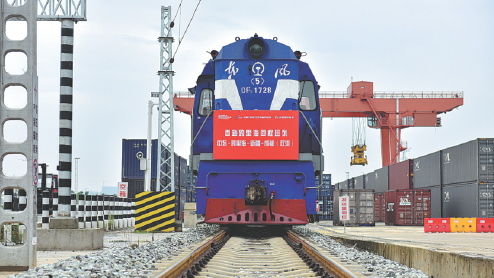Chengdu fuels dual-circulation pattern with strong business environment
Chengdu in Sichuan province is striving to boost high-quality development and further open up its economy to the outside world.
The city has integrated into the dual-circulation development pattern, which takes the domestic market as the mainstay while letting domestic and foreign markets reinforce each other, and helps to unblock the international logistics supply chain.
In recent years, the city has seized the opportunities under the Belt and Road Initiative, deepened cooperation, improved its market-oriented, legalized and internationalized business environment and attracted more than 300 Fortune Global 500 companies.
Most of these enterprises focus on areas such as high-end manufacturing, electronic information and modern services. They have strong demands for efficient international logistics supply chain services.
Chengdu showcased its achievements in setting up cooperation platforms and optimizing an open business environment at a launch ceremony of the demonstration projects built under the BRI during a forum held in Xi'an, Shaanxi province. Some enterprises have grabbed opportunities to play an active role in building those projects and made remarkable efforts in advancing the BRI.
On Aug 1, the first international cargo train on the Nizhny Novgorod-Chengdu-Ho Chi Minh City route departed from the Chengdu International Railway Port in the city's Qingbaijiang district to Ho Chi Minh City, Vietnam. It greatly shortens the distance for exporting Russian goods to Southeast Asia.
"In the past, our goods arrived directly from St. Petersburg, Russia, to Vietnam by sea, which generally takes 60-90 days," said Chen Jianfeng, deputy general manager of Chengdu Dayang Supply Chain Management. "The train is expected to take only 30-40 days to complete the journey."
The opening of this line also has a significant role in promoting the improvement of the international freight network of Chengdu, he added.
On Aug 2, the first international cargo train across the Caspian Sea-located at the border between Europe and Asia-arrived at the Chengdu (Shuangliu) Air-Railway International Intermodal Port.
The cargo of the train is 50 large containers of asphalt from the Middle East, which will be mainly used as raw materials for local construction enterprises in Sichuan, said an executive in charge of Chengdu Airport Modern Service Industry Development.
"In the past, the goods imported into the Middle East generally took the Indian Ocean-Melaka-South China Sea route, and needed about a month to complete the route," he said, adding that the opening of this new route across the Caspian Sea can save two-thirds of the transportation time for the company.
The procurement of raw materials by enterprises provides a new guarantee and saves logistics costs.
In addition to the trains traveling between provinces and cities in China and European countries, air transport has also become a driving force for the regional economy and Chengdu's opening-up to the outside world.
On May 9, a Boeing cargo plane loaded with more than 130 metric tons of mechanical equipment, electronic products, e-commerce small packages and other goods took off from Chengdu Shuangliu International Airport and arrived at the Brussels Airport in Belgium after a 14-hour flight.
Duan Xiaotao, chairman of Sichuan Hongyuan Construction Engineering, believes that the opening of the Chengdu-Brussels international freight route can meet the logistical needs of cross-border e-commerce and trade enterprises in Southwest China, provide intercontinental air freight support for enterprises and help achieve the dual-circulation new development pattern.
In the first half of this year, sales volume of Youstong, a cross-border trading platform specializing in maternal and child products, increased by nearly 50 percent year-on-year.
"We provide a self-operated warehousing system and cooperate directly with brands and factories around the world," said Qiu Shengzhi, vice-president of the company.
Ou Jiahao, general manager of Chengdubased Konetool, a manufacturer in metal tools and auto parts, said that manufacturing and processing in Sichuan is rapidly improving.
The export and processing of auto parts are in great demand overseas.
In May, Chengdu Customs issued 13 measures to promote the development of foreign trade, and increased its support in the efficiency of customs clearance and tax policy to benefit enterprises.
On May 20, the country's first large-scale overseas consumer experience center-TFS Tianfu International Bonded Commercial Center-was put into trial operation.
Zhong Bosheng, the project leader, said that about 30 percent of the center's products adopt the "offline display plus fast delivery" model, and that Tianfu New Area Customs guides enterprises in advance to familiarize themselves with the operation.
"We operate many types of goods, and accurately classify the goods before the trial operation. It is a big challenge for us to report and declare."
The construction of overseas warehouses and logistics distribution centers related to cross-border e-commerce is also developing rapidly in Chengdu.
"We continue to expand the application of customs clearance. While supporting the development of cross-border e-commerce enterprises, we fully rely on the open platform of the comprehensive bonded zone to build large-scale logistics distribution centers," said Deng Peng, deputy director of the city customs.

The first international cargo train across the Caspian Sea arrives at the Chengdu (Shuangliu) Air-Railway International Intermodal Port. CHINA DAILY

A cargo plane prepares for takeoff at Chengdu Shuangliu International Airport. CHINA DAILY

Commercial pavilions open at the Chengdu International Railway Port. CHINA DAILY








